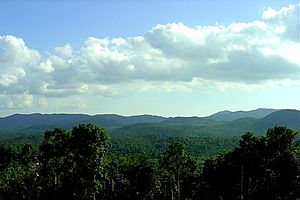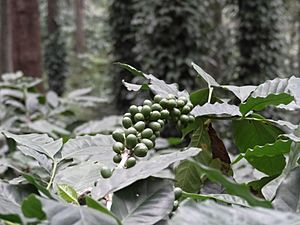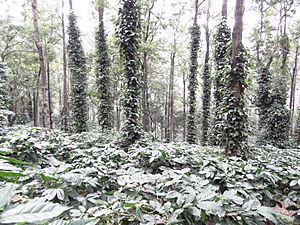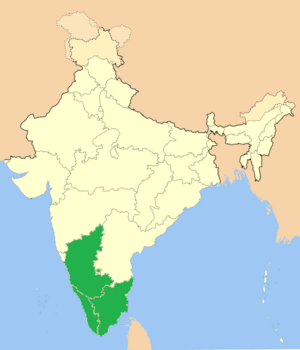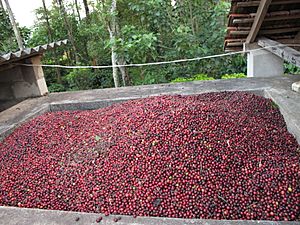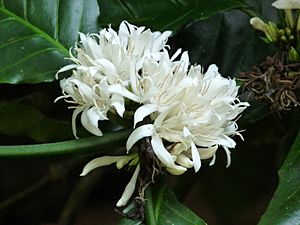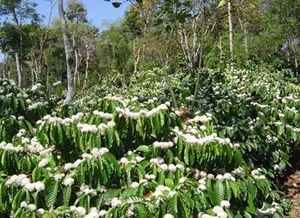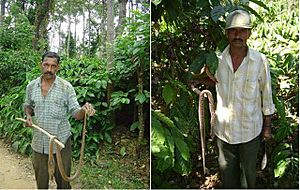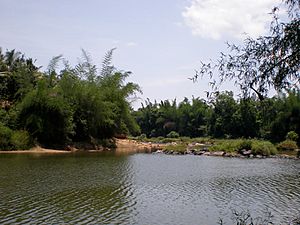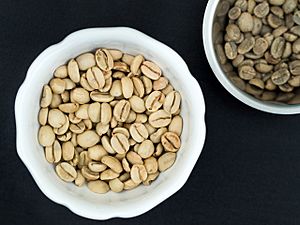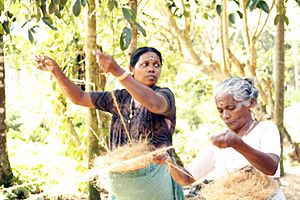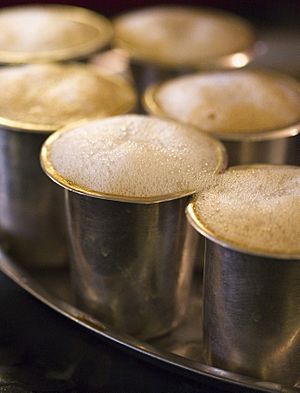Coffee production in India facts for kids
Coffee production in India mainly happens in the hilly areas of South India. Karnataka state produces most of India's coffee (71%), with Kodagu district alone making 33%. Kerala is next with 21%, and Tamil Nadu with 5%. Indian coffee is special because it's often grown in the shade, not direct sunlight, which many say makes it taste better.
About 250,000 people grow coffee in India, and most of them are small farmers. In 2009, India produced about 4.5% of the world's coffee. A lot of Indian coffee (about 80%) is sent to other countries like Germany, Russia, and Italy.
Coffee is grown in three main areas in India:
- The traditional region: Karnataka, Kerala, and Tamil Nadu.
- Newer areas: Andhra Pradesh and Odisha on the eastern coast.
- The "Seven Sister States" in Northeast India (Assam, Manipur, Meghalaya, Mizoram, Tripura, Nagaland, and Arunachal Pradesh).
Because it grows under monsoon rains, Indian coffee is sometimes called "Indian monsooned coffee." The two main types of coffee grown here are Arabica and Robusta.
Contents
History of Coffee in India
Coffee first started growing in Ethiopia, then moved to Arabia (Yemen). In India, coffee growing began thanks to an Indian saint named Baba Budan.
Around the 17th century, Baba Budan went on a trip to Mecca. On his way back, he secretly brought seven coffee beans from Yemen to Mysore in India. He hid them in his beard! Taking green coffee seeds out of Arabia was against the law back then, because Arabs wanted to control coffee growing. But Baba Budan planted these seven seeds on the Chandra Drona Giri hills in Chikkamagaluru district. Since the number seven is special in his religion, his act was seen as a religious one. This brave act started the coffee industry in India.
After Baba Budan's planting in 1670, more people started growing coffee. By 1840, the first proper coffee farms were set up around the Baba Budan Giri hills in Karnataka. Coffee growing then spread to other areas like Wayanad (Kerala) and the Nilgiris (Tamil Nadu). When the British took control of India in the mid-1800s, coffee farms grew even more, mainly for export.
At first, Arabica coffee was very popular. But a plant disease called coffee rust badly damaged the Arabica plants. So, farmers started growing a stronger type of coffee called Robusta. They also grew a hybrid (mix) of Arabica that could resist the rust. Today, Robusta is the most common type grown in India.
In 1942, the government created the Coffee Board of India to help coffee farmers and control exports. This board was part of the Ministry of Commerce and Industry. For a while, the government controlled most coffee sales, which meant farmers didn't have much reason to grow very high-quality coffee.
But things changed after 1991 when India started opening up its economy. In 1993, farmers were allowed to sell 30% of their coffee within India. By 1996, farmers could sell all their coffee wherever they wanted, both in India and overseas. This helped the coffee industry grow a lot.
Coffee Production in India
How Coffee is Grown
In the past, around the 1870s, coffee production in India slowed down because of the coffee rust disease. Many coffee farms were even replaced with tea farms. However, India still remained an important coffee producer.
In the 1940s, "Indian filter coffee" became very popular, especially in South India. This sweet, milky coffee is made from dark roasted coffee beans mixed with chicory. The main coffee beans used are Arabica and Robusta, grown in the hills of Karnataka, Kerala, and Tamil Nadu.
Coffee production in India has grown a lot. From 1971 to 1980, it almost doubled. By 2007, some farms even started growing organic coffee. In 2008, India produced about 262,000 tonnes of coffee.
Most of the 250,000 coffee growers in India are small farmers. About 90% of them have farms smaller than 10 acres. The southern states of Karnataka, Kerala, and Tamil Nadu produce over 92% of India's coffee. India exports a lot of its coffee, with Italy being a big buyer. While Arabica was once the main type, Robusta now makes up over 60% of India's coffee production because it gives higher yields. People in India are also drinking more coffee, with local use almost doubling from 1995 to 2008.
Growing Conditions
All coffee in India is grown in the shade, often with two layers of shade trees. Farmers often grow spices like cardamom, cinnamon, clove, and nutmeg alongside the coffee plants. These spices can even give the coffee a special aroma!
- Arabica coffee grows best at heights between 1,000 to 1,500 meters (3,300 to 4,900 feet) above sea level.
- Robusta coffee grows well at lower heights, from 500 to 1,000 meters (1,600 to 3,300 feet).
Both types of coffee need soil that drains well, has lots of natural material, and is slightly acidic.
- Blooming and Maturing
When coffee plants bloom, they have beautiful white flowers that only last about 3-4 days. After that, they turn into seeds. It's a lovely sight to see a coffee farm in full bloom!
- For Arabica, it takes about seven months for the fruit to grow from flower to ripe berry.
- For Robusta, it takes about nine months.
The coffee berries are picked by hand when they are fully ripe and red-purple.
- Climatic Conditions
The best weather for growing coffee involves temperatures between 73°F and 82°F (23°C and 28°C). They also need about 60-80 inches (1.5-2 meters) of rain, followed by a dry period of 2-3 months. Very cold temperatures are not good for coffee. If there isn't enough rain, farmers use irrigation to water the plants. These conditions are common in the tropical hills of South India, which is why coffee farms thrive there.
- Coffee Diseases and Challenges
One common problem for coffee plants in India is a fungus called Hemileia vastatrix, also known as coffee rust. It grows inside the leaves, and it's hard to get rid of. Another disease is "coffee rot," which can damage plants during the rainy season. It makes leaves turn black and fall off. Also, farmers need to be careful of snakes like cobras on coffee plantations.
Processing Coffee
After picking, coffee beans are processed in two ways:
- Dry processing: This is the traditional method where beans are dried in the sun. This helps keep the natural flavors from the fruit.
- Wet processing: In this method, coffee beans are fermented and washed. This is often preferred for getting more beans and better quality.
After processing, the beans are cleaned, and different types and sizes are mixed to create the best flavor. Then, the coffee is roasted and ground into different sizes.
Types of Indian Coffee
India grows four main types of coffee: Kent, S.795, Cauvery, and Selection 9.
- Kent was one of the first Arabica types grown in India, named after a British planter.
- S.795 is probably the most common Arabica in India and Southeast Asia. It's known for its balanced taste with hints of mocha.
- Cauvery is also known as Catimor.
- Selection 9 has won awards and is a mix of two other types.
Some special Indian coffee brands include:
- Monsooned Malabar AA
- Mysore Nuggets Extra Bold
- Robusta Kaapi Royale
- Organic Coffee
Organic coffee is grown without using man-made chemicals or pesticides. To sell it as organic, it needs to be certified by a special agency. India is a good place to grow organic coffee because it has deep, fertile forest soils, two layers of shade, and farmers often use natural fertilizers like cow manure. Even with these benefits, only a small area in India grows certified organic coffee. The Coffee Board is working to help more farmers grow it.
Coffee Research and Development
India has a strong system for coffee research and development, led by the Coffee Research Institute. This institute is considered the best research station in Southeast Asia for coffee. It's managed by the Coffee Board of India, which is part of the Indian government. The board's goal is to improve coffee research, quality, and sales.
The Coffee Research Institute is located near Balehonnur in Chikmagalur district, Karnataka, right in the middle of coffee farms. It studies many things like soil, plant growth, insects, and how to process coffee to make it better. The institute has a large farm where it tests new ways of growing coffee and studies different coffee plants. It also trains coffee farm managers and workers. People from other countries like Ethiopia and Vietnam have also come here for training.
There's also a special division in Bangalore that uses advanced science like biotechnology to create new coffee types that produce more beans and can resist pests and diseases.
Regional Research Stations
To help coffee growers in different parts of India, there are five regional research stations:
- Coffee Research Sub-station (CRSS) in Chettalli, Karnataka.
- Regional Coffee Research Station (RCRS) in R.V. Nagar, Andhra Pradesh. This station helps tribal people grow coffee instead of using old farming methods that harm forests.
- Regional Coffee Research Station (RCRS) in Chundale, Kerala. This one focuses on Robusta coffee, which is very common in Kerala.
- Regional Coffee Research Station (RCRS) in Thandigudi, Tamil Nadu. This station helps farmers in areas that get most of their rain from the Northeast monsoon.
- Regional Coffee Research Station (RCRS) in Diphu, Assam. This station helps promote coffee growing in Northeast India as a better way of farming than traditional "slash-and-burn" methods.
Popularity of Coffee in India
The India Coffee House chain started in the 1940s during British rule. In the 1950s, the government closed them down, but the employees took over and reopened them as the Indian Coffee House. The first one opened in New Delhi in 1957. Now, there are many Indian Coffee Houses across the country, run by employee cooperatives.
Today, modern coffee shops like Barista and Café Coffee Day are very popular. Café Coffee Day is the biggest coffee shop chain in India. People in South India drink more coffee at home than in other parts of the country.
Indian coffee is well-liked in Europe because it's less acidic and has a sweet taste, making it great for espresso. Americans often prefer coffee from Africa and South America, which is more acidic.
Indian coffee has won awards. In 2002, Selection 9 won the "Fine Cup Award" for best Arabica. In 2004, "Tata Coffee" won three gold medals at a big coffee competition in Paris.
Coffee Board of India
The Coffee Board of India is an organization run by the Ministry of Commerce and Industry of the Indian government. It was set up in 1942 to help coffee production in India.
Before 1995, the Coffee Board bought coffee from many growers and sold it. But after India's economy became more open, private companies started marketing coffee.
The Coffee Board's main jobs include:
- Promoting coffee sales and drinking in India and other countries.
- Doing research on coffee.
- Helping small coffee growers with money.
- Making sure working conditions are good for coffee farm workers.
Images for kids


